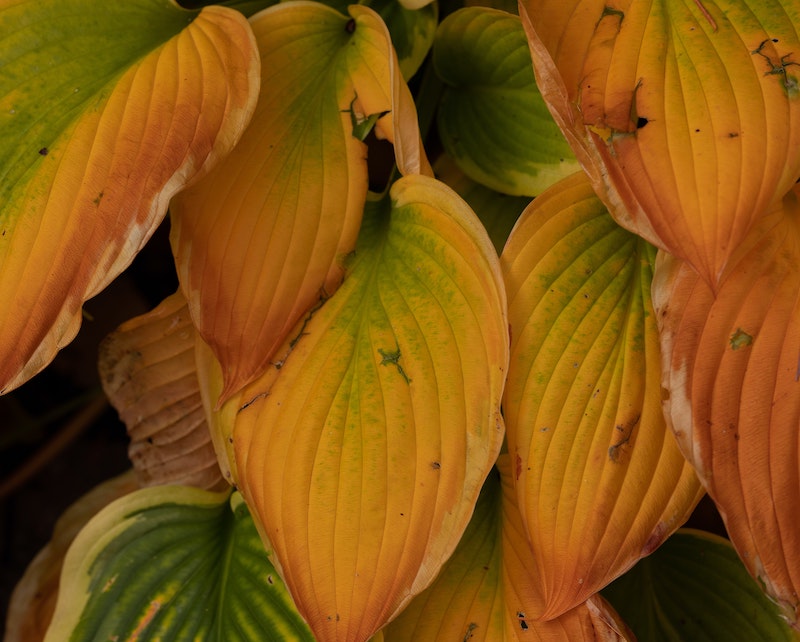Hostas are leafy plants that add greenery and texture to a landscape. These hardy plants prefer to live in partial shade but can tolerate some bright sunlight. Hostas are often used to create a border or fill in an area, so they are typically crowded together. As the plants mature and fill in, they become more cramped. This closeness reduces airflow, which can impact the plant’s health and contribute to disease. Properly caring for your hosta will ensure your plants are healthy and disease-free.

Hosta Anthracnose
Anthracnose is a fungal disease that mars hosta foliage. Hosta Anthracnose occurs when the plants are closely spaced, and air circulation is limited. Damp and low-light conditions also contribute to this fungal infection. Anthracnose does not typically kill the plant but has a visual impact.
Identifying Anthracnose
Anthracnose appears as spots with cream-colored centers and black rings along the outer, irregular edges. The center of the spot eventually degrades to the point that it becomes a hole.
Treating Anthracnose
Treat hosta Anthracnose by removing all infected leaves. Destroy the leaves so the fungus does not spread to other plants. Spray the remaining foliage and nearby plants with a fungicide. Treat and prevent Anthracnose by watering the ground around the hosta, and keep the foliage as dry as possible when watering. Further help your plants by dividing crowded hostas in the fall to increase airflow and prevent the Anthracnose fungus.
Hosta Cercospora Leaf Spot
Cercospora leaf spot is a fungal infection. This leaf spot disease is unlikely to kill the hosta, but it will visually impact the look of the plant. Cercospora leaf spot typically infects plants grown in humid areas during the hottest parts of the summer.
Identifying Cercospora Leaf Spot
Signs of Cercospora leaf spots include red or tan spots with a rust-colored border. The infected areas may give way to holes in the foliage.
Treating Cercospora Leaf Spot
Treat hosta Cercospora leaf spot by pruning damaged leaves. Remove the infected parts of the plant to contain the fungal infection. Destroy damaged parts to kill the fungus. Spray the hosta with a fungicide to treat the rest of the plant and prevent the spread. Prevent the spread of Cercospora leaf spot by watering the soil as much as possible and keeping the foliage dry. Divide crowded hostas to increase air circulation.
Hosta Bacterial Soft Rot
Bacterial soft rot impacts the stems and foliage of hosta plants. Damage to the plant, like cuts, tears, or insect damage, provides an entry point for bacteria. The bacteria rot the vegetation from within. Plants left untreated will sustain substantial leaf loss. Damp conditions, increased humidity, and warm temperatures create the ideal conditions for bacterial soft rot.
Identifying Bacterial Soft Rot
Hosta infected with bacterial soft rot will develop soft, mushy stems. The stems will have a rotten smell.
Treating Bacterial Soft Rot
Treat hosta bacterial soft rot by removing impacted vegetation. Improve drainage if that is a contributing factor to help reduce instances of bacterial soft rot in the future.
Hosta Fusarium Rot
Hosta Fusarium rot is caused by a fungus in the soil. The disease infects the roots and above-ground vegetation, killing the plant.
Identifying Fusarium Rot
The foliage of hosta infected with Fusarium rot turns yellow and brown before dying. Older foliage becomes infected first, as the bacteria starts with lower leaves before moving through the plant. The hosta plant will wilt and die.
Treating Fusarium Rot
Remove and destroy infected plants immediately. Fusarium rot is caused by fungus in the soil, making it harder to treat. Do not plant hostas in the same area again because they will likely develop Fusarium rot.
Hosta Disease Chart
|
Disease |
Identifying |
Treating |
|
Anthracnose |
Irregularly shaped spots that turn into holes with black edges |
Prune & fungicides |
|
Cercospora Leaf Spot |
Red or tan spots with rust-colored border |
Prune & fungicides |
|
Bacterial Soft Rot |
Soft, mushy stems |
Prune |
|
Fusarium Rot |
Yellowing and dying growth |
Remove entire plant |
Sources:
"Hosta Diseases and Pests." Iowa State University. store.extension.iastate.edu
"Hosta Pests and Diseases." Michigan State University Extension. canr.msu.edu
 |
Author Alison Cotsonas - Published 05-02-2023 |
